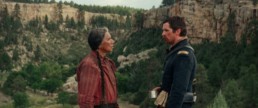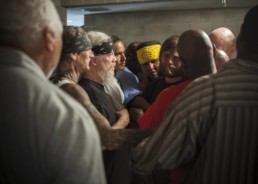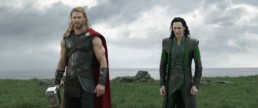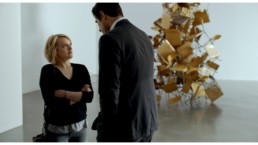'Hostiles' Review: Christian Bale's Western Is Heroic Journey Towards Respect
This review originally ran on November 28th during the AFI Film Festival
Director Scott Cooper has been a Hollywood fringe favorite since the release of his first film Crazy Heart cashed in on a career Oscar for Jeff Bridges.
Four films later, he’s proven himself to be an actor’s favorite and a lover of brooding masculine movies that flirt with awards prospects, but – aside from his first – never land that punch. Hostiles, true to form, arrived at Telluride Film Festival this year without distribution and barely found some in time to build an Oscar campaign for its star, Christian Bale, and perhaps the rest of the film.
In the late 19th century, a U.S. government mercenary in New Mexico, Captain Joseph J. Blocker (Christian Bale), is given the task of escorting his nemesis, Chief Yellow Hawk (Wes Studi), to his homeland in Montana for him to die peacefully. As someone who has made a career hunting Indians, he’s less than thrilled. From there, the film is a journey as a party comprised of soldiers and American Indians makes their way North. From the title, the theme is made clear: we are all "hostiles," and the world is built on principles that divide us.
Unsurprisingly, the film’s character arc is Bale becoming less of a villain and more sympathetic to his rival. The film is conscious of the genocidal treatment of Indians and never shies away from violence in every direction. It’s a Western that is built on many traditional principles, but the effect of the seemingly endless violence in the film eventually starts to work– aiming to erode the viewer to exhaustion to realize how damaging bloodshed truly is. In this sense, the film is more effective than enjoyable. It’s not a particularly groundbreaking entry, and yet is coherently made and becomes increasingly engaging toward the end.
It’s a Western that is built on many traditional principles, but the effect of the seemingly endless violence in the film eventually starts to work– aiming to erode the viewer to exhaustion to realize how damaging bloodshed truly is.
The biggest critique is that for a film that touts itself as progressive, the white characters are given much more dimension than their American Indian counterparts. One phenomenal actor, Adam Beach, is practically mute in the film, while almost all the white soldiers are given brooding, complex monologues and backstories. In fact, the supporting cast that is given ample screen time all shine. For example, Rory Cochrane (Dazed and Confused) is given a monologue midway through the movie about the overwhelming amount of violence and murder his character has committed and the toll it has taken on him. It’s a great acting showcase, and I wish the film had found the time for Wes Studi, Adam Beach, and Q’orianka Kilcher to get the same treatment as Ben Foster, Jesse Plemons, Rosamund Pike, and the aforementioned Cochrane. I don’t mind having Christian Bale as the protagonist, but the movie could have benefitted from a less lopsided view of the supporting cast.
Overall, Hostiles represents one of the darkest and more internal films of Scott Cooper’s filmography, and from my perspective, this is where he works best. He knows how to get the most out of his performers and addresses great themes in the midst of the larger story. I imagine his work can only get better and more refined from here. For those who have enjoyed Cooper’s previous films, Hostiles will indeed be a satisfying film to check out.
127 minutes. 'Hostiles' is rated R for strong violence, and language. Now playing at AMC Century City 15.
https://www.youtube.com/watch?v=vJz5l5ru7ws
Event Report: The Independent Cinema Showcase (ICS)
Last Sunday, December 3rd, Cinemacy was invited to cover an up-and-coming series of short films at the Downtown Independent.
Maxwell Morro, a longstanding friend of Cinemacy, along with co-host Mary Rachel Gardner, founded and hosted Sunday’s event. Showing seven short films in total, (including one starring Gardner, and one directed by Morro), this gave an array of emerging filmmakers the proper venue to display their work, bolstered by a full house of filmgoers. The seven films represented a range of genres and talents and ran between 5 minutes and 50 minutes.
While both Gardner and Morro have hosted screenings before, this Showcase marks the beginning of their goal to make this a regular staple on the film calendar. Their intention is to host a showcase quarterly, with the next one planned for Spring 2018. Here is a summary of the seven films highlighted in this season’s ICS:

Alleys
Writer/Director: Ezra Albarran
Genre: Drama, Romance
Synopsis: A short story about two recently torn apart lovers, Josh & Lani, spending their day contemplating the question...is love truly worth fighting for?

Birthday Girl
Director: Tony Pagliaro
Genre: Comedy
Synopsis: On the eve of Erin’s birthday, the universe has one more surprise in store for her. Coincidentally, so does she.

The King of Spades (Ep. 5 of The Spades Series)
Writer/Director: Joe Raffa
Genre: Drama
Synopsis: A poverty-stricken young man in need of guidance crosses paths with an aging prizefighter searching for redemption.

Loved Ones
Director: Ryan A. Nichols
Genre: Supernatural Thriller
Synopsis: A recently widowed outlier is confronted by a malevolent, supernatural force during a time when humanity and the world near a certain end. In order to restore balance, she must accept a theory that suggests she is the only living person to defeat it.

The Minuet Trilogy
Producer/Director: Maxwell Morro
Genre: Romance/Experimental
Synopsis: A young couple dreams of recollection involving their passionate relationship
with each other.

Replacing A Husband
Director: Theo Trepca
Genre: Drama
Synopsis: Recently widowed, Beauty relearns to live as a single woman in a conservative and patriarchal commune.

Voice
Director: Alexander Falcon
Genre: Thriller/Drama
Synopsis: Anthony Miller's world is set ablaze when he decides to answer one late night phone call.
Keep in touch with future ICS screenings by following Mary Rachel and Maxwell at their respective websites here:
https://kallistezoeproductions.com/
And the Winners Are... Highlights From The 33rd Annual IDA Awards
On Saturday, Cinemacy had the pleasure of being invited to Paramount Studios for the IDA Awards, one of the highest honors for nonfiction filmmakers.
The awards are voted on by all members of the International Documentary Association, so as is the case with the Independent Spirit Awards, the winners represent a consensus by the community from which these films came from. More information about the IDA can be found on their website.
A major theme of community and family can be found among the IDA. With numerous events and support laid throughout the year and building up to their awards show, this is a community looking to sustain long-term filmmaking careers rather than having its brightest bulbs flame out. The community remains extra charged given the current state of news and media: at a time where the White House refuses to even acknowledge facts and reality, the filmmakers here from all over the world are leading the charge for truth. This responsibility hangs heavy over all filmmakers as we turn to reflect on 2017 in film for the impending awards season. Here is a look at some of the film highlights from the evening:
Highlighted Film Awards:

Best Feature Film Award - Dina
(Other Nominees: City of Ghosts, Faces Places, LA 92, Strong Island)
Dina has been a documentary darling all throughout 2017 and is an impressive choice for the highest documentary honor. The film began winning awards back in January at Sundance where it took the title of the Grand Jury Prize for documentary film. From there it has played at NEXT FEST in LA, numerous film festivals, and a limited theatrical release.
Traditionally this award has been an Oscar precursor (last year’s winner was OJ: Made in America), however, this year it will not be. Dina was not one of the 15 documentaries to make the shortlist, and interestingly enough, it was the only IDA nominee here that was not. The other four will continue to campaign for the Oscar nomination and each one has a viable shot. In the end, among the documentary filmmakers, Dina was #1 – it’s heartwarming protagonist matched with singular and richly framed cinematography made it a standout.

Best Short Award - Edith and Eddie
(Other nominees: The Fight, Heaven is a Traffic Jam on the 405, Long Shot, Mr. Connelly has ALS, The Rabbit Hunt)
Edith and Eddie, ages 96 and 95, are America's oldest interracial newlyweds. Their love story is disrupted by a family feud that threatens to tear the couple apart.

ABC News VideoSource Award - LA 92
(Other nominees: Blood on the Mountain, Elián, Icarus, Obit)
A fascinating category that would only be found at a documentary awards show, these five films are noted for their excellence in using pre-existing archival materials to help tell a story. The winner, LA 92, is entirely comprised of news and media clips from the L.A. riots in 1992. It’s a true art form to put together archival to tell a story and fantastic to see filmmakers recognized for these efforts. At the risk of extending the show too long, I would not mind seeing more categories recognizing specific elements of the art of documentary.

Courage Under Fire Awards: 4 films covering Syria
(L-R) City of Ghosts, Cries from Syria, Hell on Earth, Last Men in Aleppo
Traditionally this film award goes to just 1 film that shows cinematic bravery, but in this case, 4 films have all shown merit for their essential and unbelievable courage in properly documenting the Syrian conflict for the rest of the world to see. Subjects from all 4 films were present at the awards as well as many of the filmmakers.
Notably, this award is not given every year, only when merit is needed to be recognized. No winner was granted last year, in 2015 the winner was Matthew Heineman for Cartel Land (Heineman also directed City of Ghosts, one of the 2017 awardees).

Technical Awards:
Best Cinematography: Machines
Best Editing: Dawson City Frozen Time
Best Music: Brimstone and Glory
Best Writing: Donkeyote
Award Winners announced before the event:

Emerging Documentary Filmmaker Award - Yance Ford
Yance Ford’s directorial debut Strong Island premiered to rave reviews at Sundance followed by a release on Netflix. The film has garnered praise for a personal portrait of the Ford family in light of injustice. Last week Strong Island was selected for the Oscar shortlist, it is one of 15 films vying for an Oscar nomination. Ford’s award was presented by filmmaker Charles Burnett.

Amicus Award - Abigail Disney
In less than a decade since her first entry into producing documentaries, Abigail Disney has become a formidable force in giving voices to the voiceless and making funding a reality for countless film teams, notably women and racially diverse filmmakers. Her credits are countless and this award is a tribute to how much her presence has added to the non-fiction world. Presenting her award were two of her first collaborators, and legends in the documentary world, Kirsten Johnson and Gini Reticker.

Career Achievement Award - Lourdes Portillo
Recognizing another filmmaker who has pushed boundaries with her work in a long-standing career, Mexican documentary filmmaker Portillo was on hand to receive her award.
And that’s a wrap on the IDA awards! We look forward to more coverage of the best in nonfiction film both this year and onward.
'Darkest Hour' Review: Gary Oldman Delivers a Career Best as Winston Churchill
In a very powerful opening shot, dropping us into the world of 1941 British Parliament, it’s clear that Joe Wright’s latest film will not only be a showcase for the work of actor Gary Oldman, but also a reminder of the great cinematography of Bruno Delbonnel, whose keen eye previously brought life to Inside Llewyn Davis and Amelie, among others.
Like in his previous films, Wright doesn’t miss any opportunity to let the camera do the storytelling and his collaboration with Delbonnel proves to be a great combination right from the get-go. This hopefully will be Roger Deakins' (D.P. of Blade Runner 2049) year for gold, but I’m glad to see other great visual artists like Delbonnel in the foray. But I digress, this is not necessarily a movie that people will talk about in terms of cinematography. Let’s not forget why we’re here in the first place.
Darkest Hour is foremost a biography film of Winston Churchill, a leader who remains a political hero across all party lines. The film takes place in May of 1941, with World War II and a German invasion imminent. Through peculiar circumstances, one man is at the helm of the island-based empire. Unconventional casting pays off immensely; Gary Oldman, who in real life looks or sounds nothing like Churchill, is given one of the most earned scene-chewing roles in ages. The biography wisely focuses on a very critical period of his career and world history, and that helps the film itself remained focused.
Oldman is unrecognizable, it would take a more trained eye to tell what is makeup and what is weight gain. He completely disappears into Churchill as a fully formed character. It helps that he’s a bit of a caricature, especially compared to the more ordinary supporting characters, but there is never a doubt of who we are watching on screen. It goes without saying that this is the type of performance that awards season soaks up and I expect many awards to come Oldman’s way. Interestingly, Ben Mendelsohn plays King George VI, a role that has already been immortalized on film by Colin Firth, yet Mendelsohn takes the opportunity to make his mark in this role. British royalty and leadership are the Shakespearean characters of our time, worthy of numerous portrayals and character interpretations.
There is room for all these films and they will continue to be made, perhaps as a way of preserving history. It will simply require them to be increasingly well executed and fresh in order to stand apart.
An honest critique is that this story is increasingly familiar ground for movies. Yes, I learned details about Churchill that I wouldn’t have known otherwise and it’s clear that the writers did their homework, but I wonder how many movies about one particular subject are needed? Overlaps with The King’s Speech and Dunkirk are made plain to even the most casual viewer. I was also reminded of Downfall, a truly rapturous piece of cinema from Germany - both movies are complex looks at historic leaders in pivotal, intimate moments (in that film’s case, Adolf Hitler). The setting will feel very familiar, both films spend much of the time in bunker-style war rooms. Downfall will always be more captivating to me because the psychology behind a man whose villainous scheme is crumbling by the second has more intrigue than a hero on the correct side of history. There is room for all these films and they will continue to be made, perhaps as a way of preserving history. It will simply require them to be increasingly well executed and fresh in order to stand apart.
In today’s political climate, when American politicians are nearly all bought and sold by corporations, it’s unfortunately hard to imagine a time when solutions to the great problems were black and white, and great minds could disagree through discourse instead of stomping their feet. This is the great void between the many classic political films of yesteryear, which makes it hard to apply the lessons of leaders like Churchill by today's standards. Regardless, there are lessons here we can apply to our daily lives. Never surrender in the face of adversity and reach out to the people around us for wisdom, even your opponents. These are the qualities that make Winston Churchill, and all those who portray him, live on in the generations to come as we face our own darkest hour.
Darkest Hour is rated PG-13 for some thematic material. 125 minutes. Opening at .. this Friday.
'The Work' Review: A Human Portrait of Rehabilitation Behind Bars
Non-fiction filmmaking comes in all shapes and sizes.
Some films attempt to cover global-scale issues spanning the continents. Others take place within the confines of a single room. Jarius McLeary’s new documentary The Work falls into the latter category. The entire runtime takes place in the span of four days, all within the walls of a chapel at a maximum security prison.
Folsom Prison, near Sacramento, CA, is widely known by name for the iconic Johnny Cash tune, yet unlike many mythologized prisons, is still fully operating today and full of life-sentenced killers and felons. A unique group therapy practice, known simply as "The Work," is employed annually at the prison, and this film is an intimate archiving of one year’s practice. Interestingly, the group is not solely inmates, but a handful of individuals from the outside with no criminal backgrounds who are also brought in to participate. It isn’t made clear exactly why they are brought in, but it gives us even more unique characters to discover. They too, like the inmates, are about to enter a transformative therapeutic experience. Throughout the four days, we watch as numerous characters apply a unique form of group therapy with hopes of extracting emotion from men who may not have known they were capable of having it.
'The Work' leaves the larger conversations on prison reform and macro topics for another film and instead allows us to know characters at their most vulnerable state.
Early on, the film teases that this program is an opportunity for the inmates to set aside their racial gang affiliations and all work together. And surprisingly, there is little tension between men of different ethnicities. This text intro asks a question that the film doesn’t fully answer: When the men leave this therapy, how do they interact with each other afterward? It’s clearly a very effective practice, tailored specifically to convicts, but the film could have benefitted from (if even permissible) following through on this question by showing or telling us what life was like outside the chapel walls and inside the prison yard. Or perhaps omitted this statement altogether.
The style of the film reveals itself as camera operators are occasionally seen capturing the different angles of the action. It’s a bit distracting to see the cameramen (including, unfortunately, in the final shot of the film) but when the film does have its moments, they land. The group therapy ‘work’ is almost unthinkable to those of us without criminal backgrounds. It’s a tense, focused, often physical, mind bend to get individuals to a point where they can properly express their emotion. These are hardened men who have likely never been able to express their emotions in a healthy manner. It may look disturbing to us and that is the point of the film. What matters is that it works. By the end of these four days, we’re told the statistics are undeniable about how the program has made a difference.
In the end, this is a human portrait that helps bring to light some of the dark realities that face those behind bars. The Work leaves the larger conversations on prison reform and macro topics for another film and instead allows us to know characters at their most vulnerable state. And so, perhaps the film will move those who see it to recognize the many men in our country who are locked up as not merely a statistic of violence, but individuals who, with proper education and emotional healing, could reach reform. A program like “The Work” is a step toward more noble treatment and therefore a healthier society for free people and convicts alike.
'The Work' is not rated. 89 minutes. Now playing in select theaters, on demand 11/21.
'Thor: Ragnarok' Review: Indie Favorite Taika Waititi brings fresh perspective to Marvel Universe
Covering the Marvel Cinematic Universe from a critical perspective is always interesting: the behemoth franchise never missteps or whiffs, but often fails to feel like an individual film to be remembered.
The most inarguably flat film of the entire franchise is Thor: The Dark World. While we all have our favorites (or least favorites), this cold, heartless sequel has never again been brought up in conversation since its release. With the first outing of Thor, a compelling character arc was put in place: our hero went from being a brash, arrogant and clueless character, to a more grounded hero by the end of the film. It’s a great journey but it only lasts one film. So by the second Thor film, there was no place for him to go forward and the writers didn’t even bother. This, more than any other reason, is what made the second film so stale.
So where to go from there? If there is ever proof that anything can be great in the hands of the right person, it is Thor: Ragnarok. Entrusted in the hands of indie favorite Taika Waititi - whose last two films Hunt for the Wilderpeople and What We Do in the Shadows are some of the best comedies of the decade - it was anyone’s guess what a massive scale blockbuster would look like. To our delight, the film more closely resembles the work of Waititi than a conventional Marvel film, and we are all here to benefit from it.
From the very get-go, where we see Thor in action on some brooding, otherworldly setting, there is a juxtaposition from the grandiose visuals of the Thor universe met with the oddball Waititi humor that never fails to deliver. For the first time in awhile, it feels like a director has taken command of the reins of their Marvel movie. Mind you, unlike most sequels to bad movies where they attempt to revise history or scrap previous entries, this film embraces all the story points from the last film but chooses to have a lot of fun with them. The balance of mythology from Thor with humor from the director is a sight to behold.
For the first time in awhile, it feels like a director has taken command of the reins of their Marvel movie.
The plot on its own could be a more straightforward tale: An evil villain (Cate Blanchett) who has a history at Asgard enters into the foray with the intention of ruling over the entire galaxy. Thor (Chris Hemsworth), meanwhile, is thrown off guard again and lands on a junkpile planet where, in order to escape, he must serve as a gladiator. Borrowing cues from throughout the decade, I’m struck with how well employed this 80s homage is– by setting it on a specific planet, it gives the entire universe a more layered feeling, where certain places have different atmospheres than others. The balance between the two planets, the regal Asgard and the synthesized 80s-inspired second planet, is a great contrast and the variety makes the whole adventure a delightful romp.
Driving home from the film, I passed by the wheat-pasted character posters from the movie. Often, these are comical in how they feature characters who are flat or given little screen time but are beefed up via their own poster. I’ve never seen the opposite so true: Ragnarok sports nine characters on these posters, and each one of them gets a memorable moment to shine on their own. Thor and Loki (Tom Hiddleston) are no surprise, but the entire ensemble has a great addition to the story, much resembling what made The Avengers such a special film. It’s perhaps more impressive given that half of them are fresh faces. And if that were not enough, there are even more characters (who don’t get their own poster) who also are fantastic contributions. This review is light on spoilers and plot points given how fun it is to witness firsthand.
Of the Marvel movies, the only one I can actively recall re-watching is the original Avengers. After this film, I can safely say I’d be thrilled to relish in Thor: Ragnarok again; with humor, vision, and sincerity, the bar has been raised for what Marvel can accomplish with this outing and I hope its look invites more brilliant directors to jump into the foray.
'Thor: Ragnarok' is rated PG-13 for intense sequences of sci-fi violence and action, and brief suggestive material. 130 minutes. Now playing in theaters everywhere.
'An Inconvenient Sequel: Truth to Power' Review: Continuing the Conversation on Climate Change
In 2006, An Inconvenient Truth transcended what was thought possible from a documentary film and started a movement of cultural awareness toward climate change.
I was in grade school when I saw the film at the Mayan Theater in Denver, CO. While my well-read older sister had been reading about global warming for years prior (thanks to this magazine issue), I consider An Inconvenient Truth to be the beginning of my own journey toward environmental activism, which I continue regularly today, and I was far from alone. From that film’s end credits on, the call to action has dispersed into numerous topics due to the global nature of the issue. For some, the fight is against fossil fuels; for some, the fight is against deforestation and habitat loss; for some, the fight is against excess consumption. The list is long, detailed, and all relevant. Nothing is happening quickly enough, and the problem is worse than anyone hoping to get elected will tell you, so it isn’t a surprise there is room for a sequel to the original, monumental film.
For a sequel to a film that started these offshoot branches, what becomes the point of focus? The sequel doesn’t repeat Al Gore’s presentation of information. In fact, it doesn’t seem like the film is meant for those who are climate skeptics, perhaps intrinsically knowing they are not going to see it. Instead, the filmmakers take an approach of following Al Gore around the world, giving us a view into the in-between moments as he shares this information, confronts skeptics, and in one especially engaging moment, negotiates with government leaders at the Paris Climate Agreements.
Gore’s mission is to educate activists around the world who can help be the messengers to the people and organizations who are fueling an opposing denial. The film is not a deep dive into topics and specific issues. Nor is there a large sense of specific initiatives shown to viewers that they can take home with them. I’m torn because I recognize that of the environmental documentary sub-genre, this will be the one that remains the broadest. It can’t spend time at every place of advocacy, Gore is trying to launch movements from the top-down. But at the same time, Al Gore’s films will have the largest megaphone of their peers: they needed to use it more!
For someone who is already inclined toward this movement, the film is a refreshing reminder that action needs to happen, but it doesn't offer viewers the action steps in the way it could.To this day I still remember the powerful ending credits to the first film, as a series of legitimate steps rolled across the screen. Gore knows more about the subject than any of us, but I don’t feel like I learned any new ways to take action from this film, and that is an opportunity not properly recycled.
Gore knows more about the subject than any of us, but I don’t feel like I learned any new ways to take action from this film, and that is an opportunity not properly recycled.
I saw this film at an IDA screening that followed with a Q&A hosted by Anne Thompson. The directors of the film, husband-wife duo Bonni Cohen and Jon Shenk, decided to take a more follow-filmmaking approach with their powerful subject, and to their credit, seeing him a bit off the script works well. One of the most interesting things gained from the Q&A was that in reality, Al Gore is still a very damaged, internally conflicted individual, which is fascinating considering how public of a life he lives. It’s impossible to imagine what the 2000 election loss must have felt like for the person at the helm of it; there was no consolation for that moment and the filmmakers suggest he’s still scarred by that. We get some sense of that, but there was much more emotional weight in the first film and I would’ve liked to see this vulnerability as they described. If the movie is going to be all about Gore, it could have leaned a little further. But again, this appeals to someone who already respects him and wants to follow his action plans and with these story critiques, it’s still an important subject for audiences to see.
I make no secret of how important it is to change our habits and take as many steps as possible instead of sitting back and waiting for Al Gore to fix it. And of course, with a President who denies its existence, the only way we’re going to beat it is by doubling down. There’s a fine line between inspiring people to change and scaring away potential allies. But in the spirit of the film, and considering An Inconvenient Sequel lacks potential tangibility for viewers, I want to offer 4 extremely easy consumer steps to help fight climate change:
-
- Cut down on using plastic: There is a garbage patch in the Pacific Ocean twice the size of Texas, primarily full of plastic. We are near the point where there will be more plastic in the oceans than fish. This all comes down to Western society’s throwaway culture, serving everything in single-use containers. There is no need for a single-use straw and the amount that are thrown away every day is insane. Do your part and request no straw with your next drink. (more info: https://onelessstraw.org/)
-
- Stop eating beef: I was thrilled to hear in the Q&A that Al Gore is a vegan now, and yet still perplexed and disappointed this wasn’t once mentioned in the film (I imagine for fear of alienating people to actually change their habits instead of remaining complacent). But the reality is, eating meat, especially at the degree most Americans do, is beyond unsustainable. You can learn much more why facts here: http://www.cowspiracy.com/facts/ However, there are many tasty alternatives, so have no fear, I’ve been off it for years now and frankly, I don’t miss it.
-
- Carbon off-set your flights: Airfare is one of the craziest high contributors to global warming. It is extremely important to reduce the amount of flying one does, and additionally, here are two websites to first calculate and then help reduce your carbon footprint for not too expensive a price:
- And specifically related to this film: After you see the movie, go onto IMDb and give it a fair score. Not saying you have to give it a 10/10, but at the moment it’s not properly represented. The website is notorious for internet trolls, and currently, 1/3 of the votes for this film are a 1/10. These are not film critics’ opinions, they are denialists trying to sabotage it. Every fair rating on IMDb helps counterbalance these folks, a small but noble step.
'An Inconvenient Sequel' is rated PG for thematic elements and some troubling images. 98 minutes. Now available for purchase on Blu-Ray and DVD.
'The Square' Is a Satirical Look at Affluence And Modern Art
About once a year, if we’re lucky, a movie comes along that transcends the labels of ‘comedy,’ ‘drama,’ and other classified genres.
It will also prove that with top-tier filmmaking, you can utilize a full emotional range to tell a story. It is safe to say we have an entry for 2017 in Ruben Östlund’s The Square.
A modern art museum in Sweden, in the midst of vying to be cutting edge while also needing to maintain overhead and encouraging people to actually visit, is getting ready for it’s newest, boldest exhibit: “The Square.” At the helm of the museum is Christian (Claes Bang) who lives in a swanky apartment, drives a Tesla, and has no trouble scoring beautiful women. Because this new exhibit is almost entirely focused on helping people and trusting strangers, Christian presents himself with the challenge of upholding the artistic vision of altruism in the rest of his life.
In reaction to his generally self-serving behavior, the new exhibit pushes Christian out of his comfort zone. Yet in every earnest (or disingenuous) attempt to help other people – his co-workers, the homeless, family members – there is a bitter, comical pushback. The results are absolutely hilarious, perhaps because of how cringe-worthy and honest the situations are and how people react while trying to fall into societal norms. What is captured on screen is absolute magic.
In most American films, when we see characters who are wealthy, it is most often glamorized or normalized. Here, as was true of his last film, Östlund takes a critical examination of wealth in a way that we all can take a lesson from...
By using the world of modern art and affluence as its setting, The Square allows for any bizarre features to be fair game, while also utilizing cinematic artistry when necessary. Most importantly, this film is a satire of the wealthy do-gooders who reek of hypocrisy without even realizing it. In most American films, when we see characters who are wealthy, it is most often glamorized or normalized. Here, as was true of his last film, Östlund takes a critical examination of wealth in a way that we all can take a lesson from (I will never be able to walk by a homeless person begging on the street again without being reminded of how this movie handles that everyday scenario).
To English-speaking audiences, a trio of recognizable faces each plays a supporting role– Elisabeth Moss as a naive reporter. Dominic West as a self-serving artist. Lastly, Terry Notary, whose name doesn’t carry star power, but who does motion capture for the Kong and Planet of the Apes movies. Here, Notary plays a controversial performance artist and I’ll only say his animal motion capture work gets to play off extraordinarily. The star of the film remains Claes Bang, whose deadpan delivery as Christian, no matter what scenario he finds himself in, is both endlessly relatable and at times hysterical.
It is not required that you see Östlund’s last feature, Force Majeure before you see this film, however, it does prime you for what to expect from his particular style. His preceding film also deals with painfully comedic scenarios of an affluent family, in that case at a ski resort. That being said, the ideas and aspirations that Östlund introduced in Force Majeure are delivered in greater extremes in The Square, and the result is a more savory meal of a film.
It’s too early to see what the competition will be like for the Best Foreign Language film Oscar. History has proven that specific category has some of the most fallacy of the already fallible awards, but my reaction would be that this film is a shoe-in. The Square represents the first truly amazing movie of the fall awards season, and one I hope to return to and think about for many years to come.
'The Square' is rated R for language, some strong sexual content, and brief violence. 142 minutes. Opening this Friday at The Landmark and ArcLight Hollywood.








